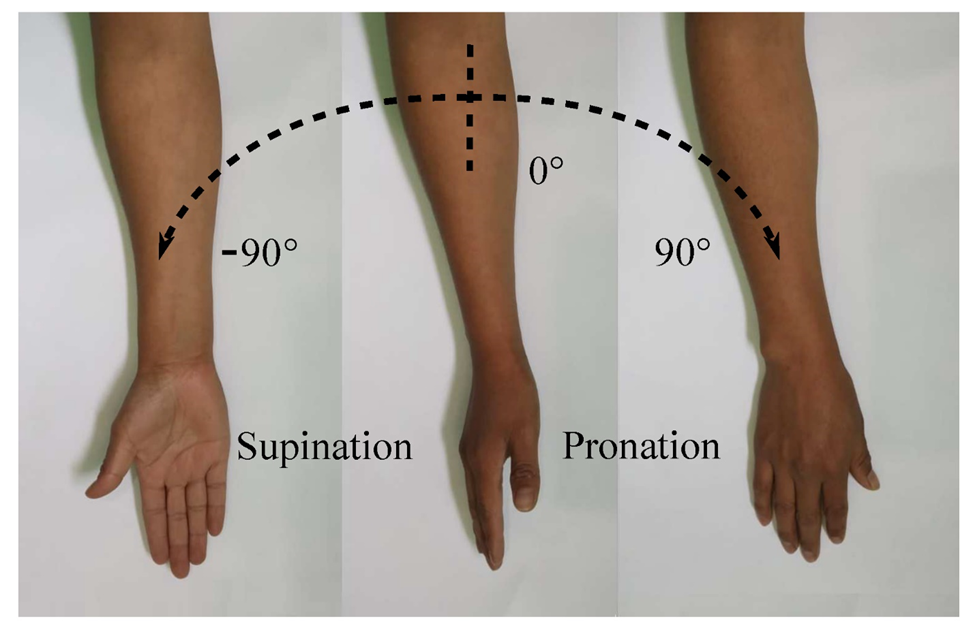A nurse is collecting data about a client’s range of motion. Which of the following instructions should the nurse give to the client to observe the elbow rotate for supination?
“Turn each of your hands and forearms so your palm is facing down.”
“Take each of your hands and touch your shoulders.”
“Turn each of your hands and forearms so your palm is facing up.”
“Move each of your arms to rest at your sides.”
The Correct Answer is C
A. “Turn each of your hands and forearms so your palm is facing down.”
This describes pronation, not supination. In pronation, the palm faces down, and the radius crosses over the ulna.
B. “Take each of your hands and touch your shoulders.”
This describes flexion at the elbow joint, not supination. Flexion involves decreasing the angle between body parts.
C. “Turn each of your hands and forearms so your palm is facing up.”
This is the correct choice. Supination involves turning the hands and forearms so that the palms face up, and the radius and ulna are parallel.
D. “Move each of your arms to rest at your sides.”
This describes adduction, bringing the arms back to the sides of the body, not supination.

Nursing Test Bank
Naxlex Comprehensive Predictor Exams
Related Questions
Correct Answer is C
Explanation
A. Provide a diet high in protein.
During the oliguric phase of acute kidney injury (AKI), there is a risk of electrolyte imbalances, including elevated levels of blood urea nitrogen (BUN) and creatinine. Restricting protein intake is often recommended during this phase to manage azotemia and prevent the accumulation of waste products that the kidneys may struggle to excrete.
B. Provide ibuprofen for retroperitoneal discomfort.
Ibuprofen and other nonsteroidal anti-inflammatory drugs (NSAIDs) are contraindicated in AKI. They can further compromise renal function and may contribute to acute tubular necrosis. NSAIDs can also affect renal blood flow, leading to worsening kidney function.
C. Monitor intake and output hourly.
Monitoring intake and output (I&O) is a critical nursing intervention during the oliguric phase of AKI. Hourly monitoring helps assess renal function, fluid balance, and the effectiveness of interventions. It allows for early detection of changes that may require prompt intervention.
D. Encourage the client to consume at least 2 L of fluid daily.
In the oliguric phase of AKI, fluid intake is often restricted to prevent fluid overload. Encouraging excessive fluid intake may contribute to fluid retention and worsen the oliguria. Fluid management is carefully regulated based on the individual client's needs and renal function.
Correct Answer is A
Explanation
A. Check that the client lifts the walker and then places it down in front of her.
To ensure proper use of a standard walker and the safety of the client, the nurse should check that the client lifts the walker and then places it down in front of her. This sequence of lifting and moving the walker forward provides stability and support during ambulation.
B. Walk in front of the client to guide her in moving the walker.
The nurse should walk beside or slightly behind the client to provide support and supervision. Walking in front may hinder the client's ability to maneuver the walker.
C. Have the client move one leg forward with the walker.
The proper technique is for the client to move the walker forward and then step into it with the affected leg. Moving one leg forward with the walker may compromise stability.
D. Make sure that the upper bar of the walker is level with the client’s waist.
The correct height of the walker is essential for proper use. The walker should be adjusted to the client's height, with the top bar at the level of the client's wrists when their arms are at their sides, not at the waist.
Whether you are a student looking to ace your exams or a practicing nurse seeking to enhance your expertise , our nursing education contents will empower you with the confidence and competence to make a difference in the lives of patients and become a respected leader in the healthcare field.
Visit Naxlex, invest in your future and unlock endless possibilities with our unparalleled nursing education contents today
Report Wrong Answer on the Current Question
Do you disagree with the answer? If yes, what is your expected answer? Explain.
Kindly be descriptive with the issue you are facing.
